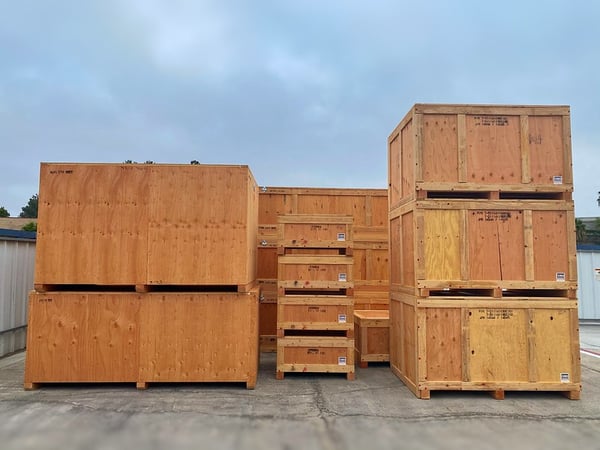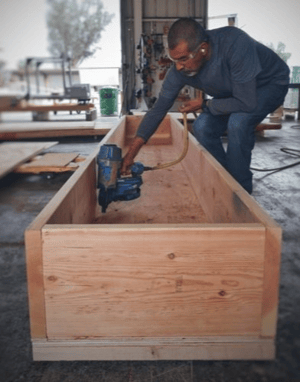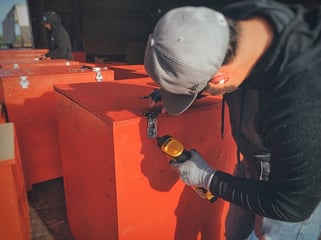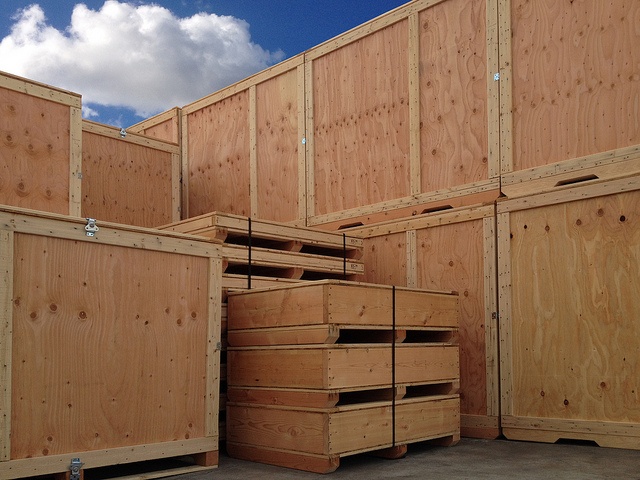When it comes to buying vs. building crates most manufacturers would prefer to buy shipping crates from a supplier. Instead of spending time and energy on building wood crates, they can focus on their core business.
While most manufacturers opt for buying crates from a supplier, some still choose to build the shipping crates they need in-house. If your company is a member of this dwindling group, before you begin building, there are a few points to consider that might make you rethink your decision.

Consider All Costs
Today’s crating and shipping industry is wildly competitive. This means, that finding shipping crates at an affordable price is pretty easy.
Crating companies want your business, so they are willing to negotiate to land your account. This equals competitive rates and even possible discounts. Not so much with building your own shipping crates. If you choose to build in-house you should be evaluating all costs, such as:
| Man Power Costs | Bottom Line Costs |
Compliance Costs |
| Material procurement cost | Workers' compensation for constructing wood crates | Posting Prop 65 signage for sawdust |
| Labor for crate design | Cost of tools (dust collector, saw, nail gun, drill, hammer, etc.) | OSHA required signs for ear, eye, and hand protection |
|
Labor for cutting materials |
Materials costs (wood, hardware, screws, handles, etc.) |
ISPM 15 heat treatment requirements for overseas crates |
| Labor for assembling crate | Cost of storage space for raw materials | OSHA Safety training crate building tools |
| Labor for packing the part | Maintenance cost for tools | |
| Labor for cleaning | Employee training for crate construction | |
| Employee training for safety with tools | ||
| Overhead (electricity to power tools, compressor, etc. ) | ||
| Disposal of scrap materials |
Time Considerations
 Your core business should be your priority. When you decide to build wooden crates in-house, you are ultimately taking time away from your core business activity, which could slow production and profits! Ask yourself, "Could these employees be better utilized in other more important areas of my business?"
Your core business should be your priority. When you decide to build wooden crates in-house, you are ultimately taking time away from your core business activity, which could slow production and profits! Ask yourself, "Could these employees be better utilized in other more important areas of my business?"
Just think, building shipping crates doesn’t begin with the manual labor involved—it starts with brainstorming sessions to come up with ideas, then designing the wooden crate, creating the cutting sheets, planning the build, and more. The process is lengthy—do you have time for this? And more importantly, do you have the space to do the job right?
Space Considerations
 When you decide to build your own shipping crates in-house, you will need ample space to store supplies, materials, and of course, the actual crates. Not only will this take up space, but you will also end up spending precious capital should you conclude that you cannot afford to lose that space long-term.
When you decide to build your own shipping crates in-house, you will need ample space to store supplies, materials, and of course, the actual crates. Not only will this take up space, but you will also end up spending precious capital should you conclude that you cannot afford to lose that space long-term.
In this case, you will have to pay to store your inventory off-site. One last thing to consider about space: it takes a large amount of space to build your own crating in-house. Could the space you are using for this be used to focus more intently on your core business activities? Could that space help boost production, which could ultimately boost your bottom line?
Quality, Safety, and Workmanship Considerations
 Not everyone who can build can build well. Are crate building and manufacturing one of your specialties? If not, the quality of your crates might not measure up to the quality of a professional builder. Not only might the appearance look a little shabby, but the durability may be on the low end.
Not everyone who can build can build well. Are crate building and manufacturing one of your specialties? If not, the quality of your crates might not measure up to the quality of a professional builder. Not only might the appearance look a little shabby, but the durability may be on the low end.
In this case, your shipment could sustain damages which will result in repair work (cha-ching), reshipment and/or replacement of the contents of the shipment (cha-ching), and/or possible legal action (double cha-ching!).
Conclusion
In the end, most manufacturers choose to stick to what they do best and leave the crate building to the professionals. This way, the quality and profitability of their core business remain intact, while the quality of their packaging is never compromised.




